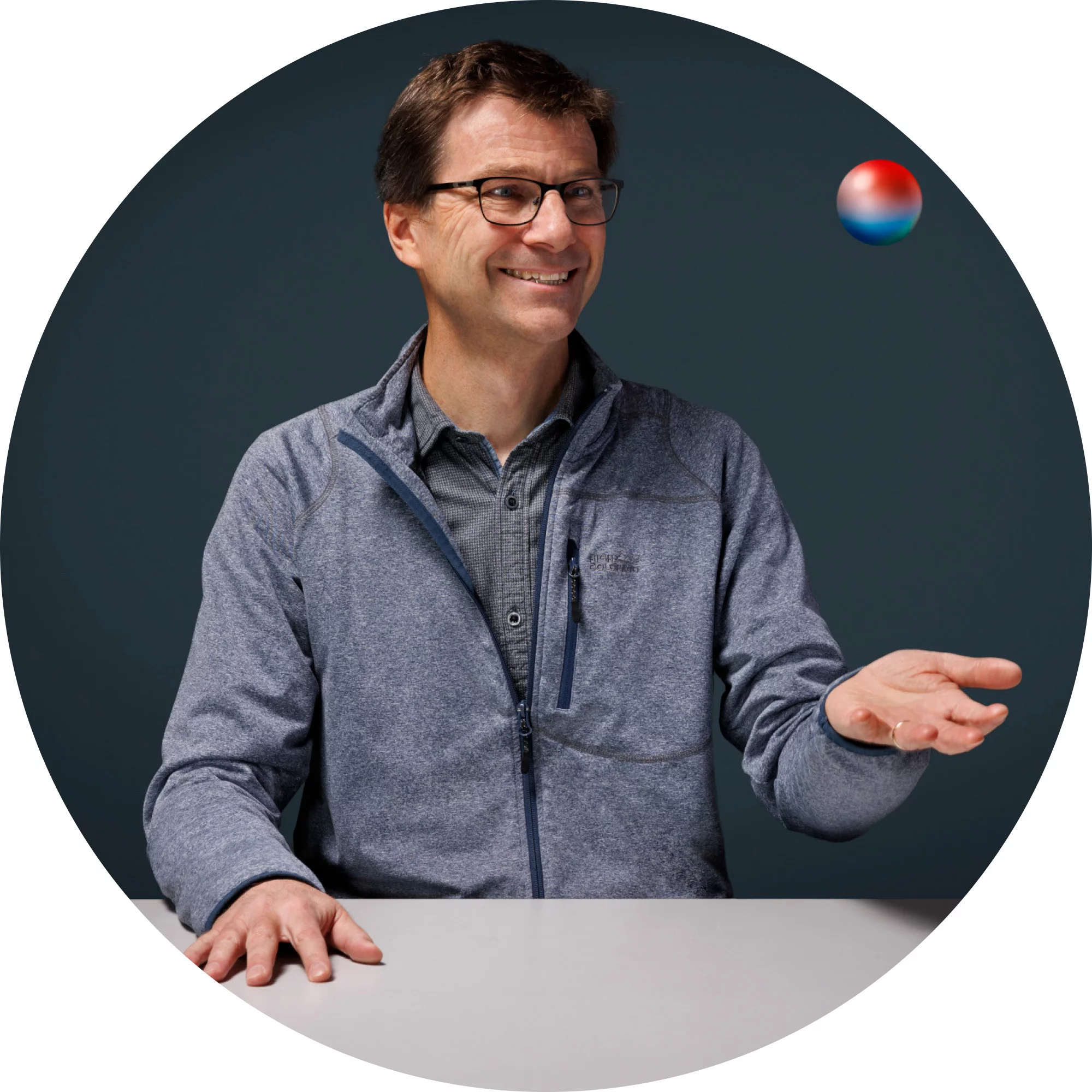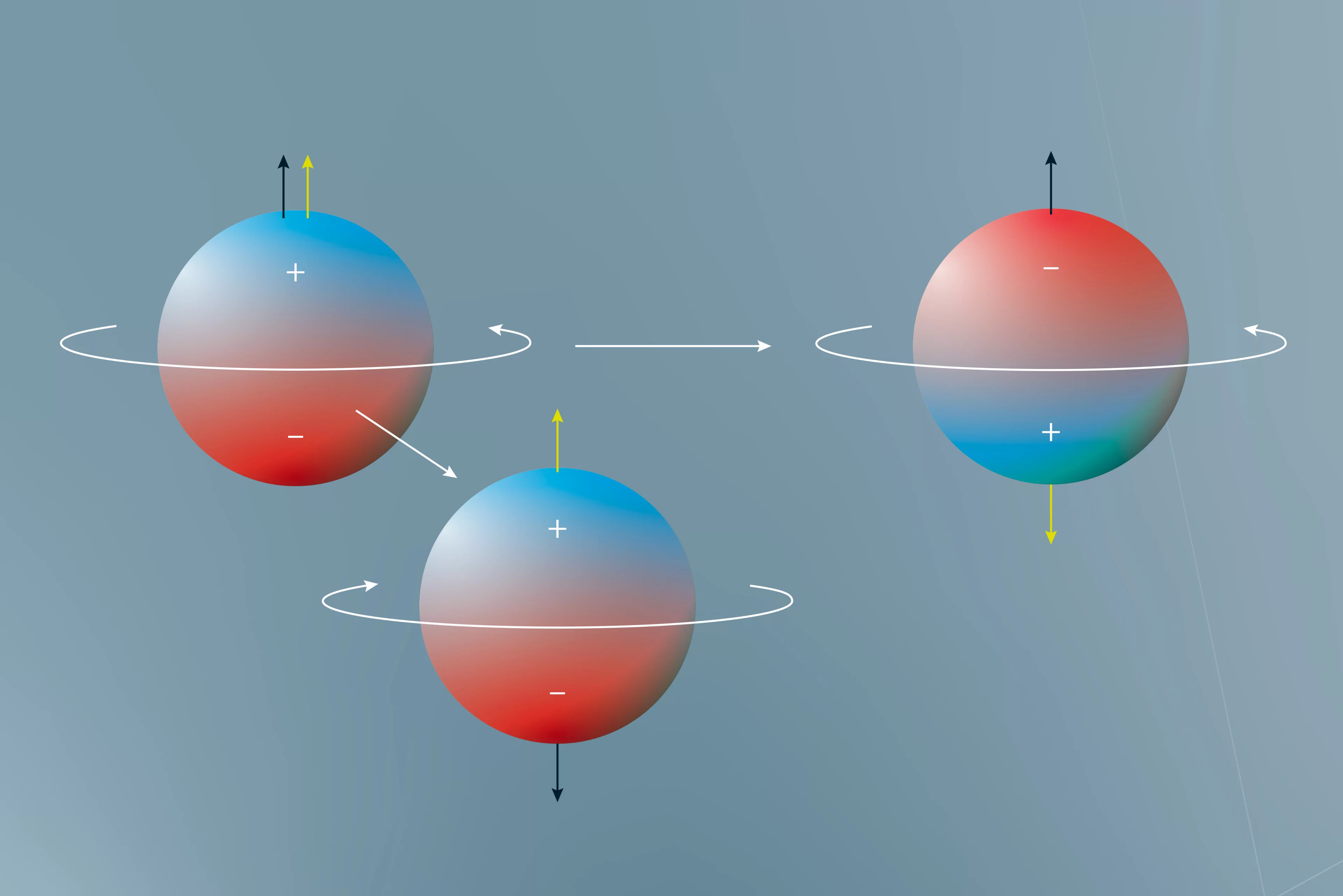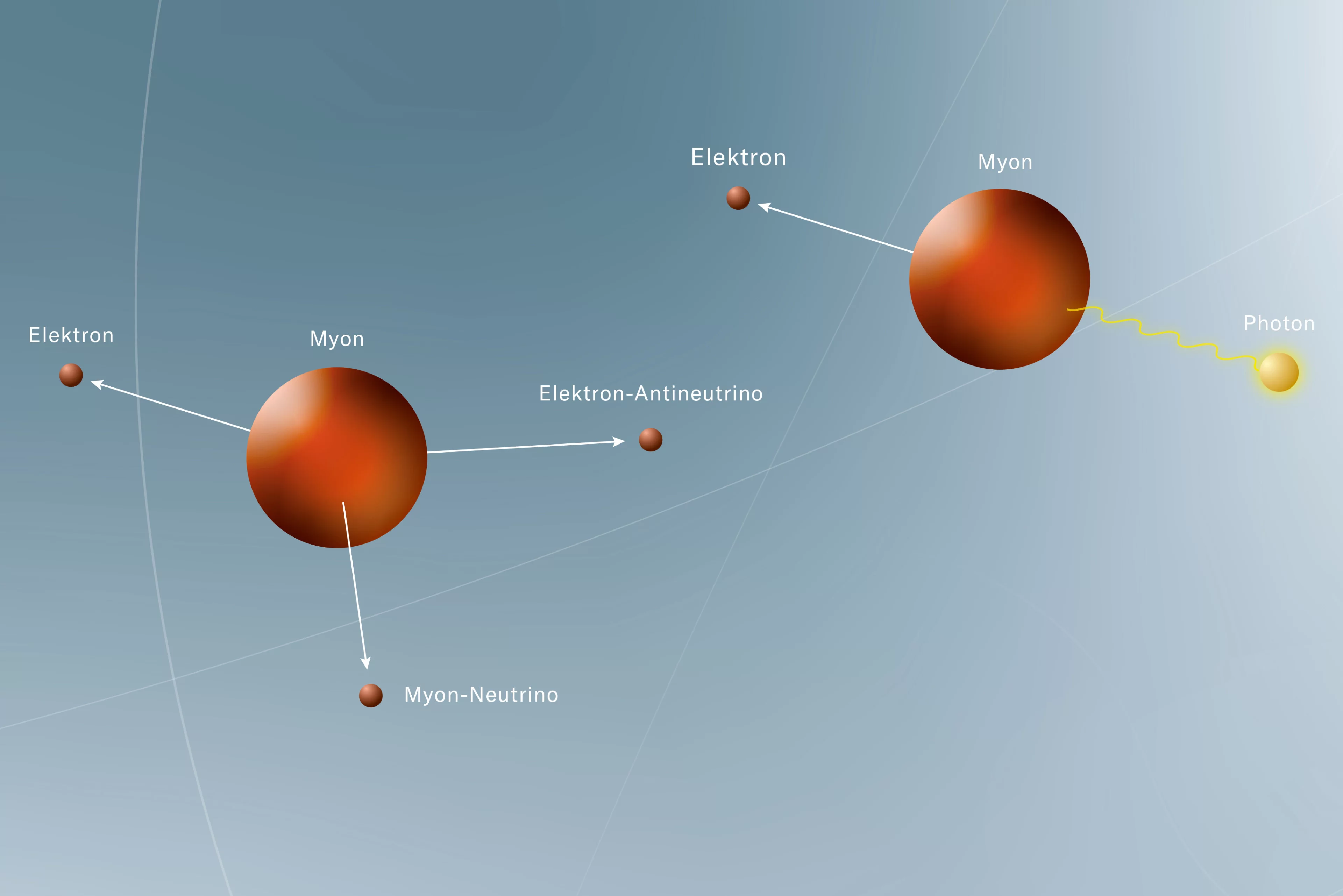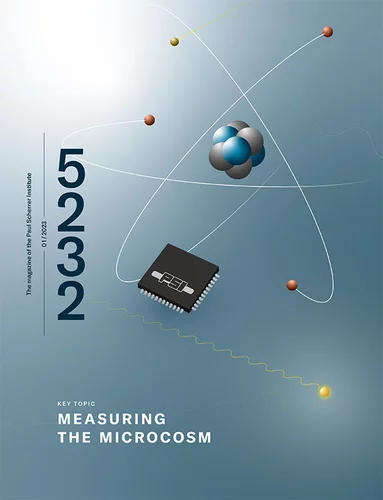The Standard Model of particle physics describes our visible universe with incredible precision. Yet researchers are not entirely satisfied with it and are trying to find gaps in the theory. PSI’s unique infrastructures play a key part in their mind-boggling experiments.
Picture a dark room. Standing in the middle, a pedestal supporting a work of art fashioned from pure gold and magnificent gemstones, resembling the death mask of Pharaoh Tutankhamun. Nothing should divert your gaze from this perfect beauty. There is just such a work of art in physics: the Standard Model of particle physics. It describes all visible particles of the universe, as well as three of the four forces of nature within it. All experiments that have been performed on – or with the aid of – elementary particles confirm this theoretical concept, again and again. So there’s no reason to peer into the dark corners behind the Standard Model, right?
Klaus Kirch disagrees. “We are very happy with the Standard Model,” says the head of the Laboratory for Particle Physics at PSI and professor at ETH Zurich. “But it’s not the last word.” That’s typical for a physicist: no theory is so perfect that it can’t be questioned. And the Standard Model is far from perfect. It leaves several questions open, such as how gravitation can be compatible with the other three forces of nature. Or why there can never be “nothing”: because after the Big Bang, more matter was left over than antimatter, whereas according to all theories they were created in exactly the same proportions and should have annihilated each other. Anyone deeply involved in astrophysics is perplexed by the fact that stars in galaxies move as if a large invisible mass were tugging on them. They use the term “dark matter” to describe this poorly understood phenomenon. Although it has never been observed, researchers are sure it exists.
These are all questions for which the Standard Model gives no answer. “That’s why we’re trying to bring light into the darkness where the inconsistencies are especially great,” Kirch says. Numerous experiments serve as “flashlights” meant to illuminate even the dark corners. That’s difficult, though, because the Standard Model outshines everything. So one needs particularly sharp eyes to see something back there.
There are basically two complementary ways to achieve this. At PSI, physicists use high-precision equipment to observe particles with very low energies in order to detect extremely rare transformation events. These experiments are smaller than the alternatives and usually cost only a few million Swiss francs; the teams are a manageable size of 50 to 100 researchers, where everybody knows everyone else. PSI has an outstanding global reputation in this discipline and is in fact the only place some experiments can be carried out with such precision.
Researchers at CERN are taking the second path: they fire particles with high energies at each other and observe whether new heavy particles arise from the concentrated energy. Such experiments are CERN’s specialty and require gigantic machines such as the 27-kilometre-long ring cyclotron Large Hadron Collider (LHC), where many thousands of researchers work.
Shielding chamber in a class of its own
The provisional crowning glory of the experiments conducted at PSI is n2EDM. PSI researchers love abbreviations like this; they immediately tell insiders what is being investigated. In this case it is the electric dipole moment of the neutron. The Standard Model essentially says that the neutron has no electric dipole moment measurable by current means. There are theories, however, that allow it. These assume that there might be a tiny charge separation inside the uncharged neutron. If this dipole moment were measured experimentally, these theories could at least partially explain the dominance of matter over antimatter.
To make such a measurement possible, however, the researchers have to block out any interfering magnetic field, in particular the Earth’s magnetic field, because the electric dipole moment of the neutron – if it exists at all – is extremely weak. To this end, Klaus Kirch’s team has built a shielding chamber weighing more than 25 tonnes, with walls made of several layers of a nickel-iron alloy. Within this five-metre-tall colossus stands a second chamber that further reduces the magnetic field. The field inside is a hundred thousand times weaker than outside. That makes this room the best magnetic shielding chamber on this scale worldwide.
The experiment takes place inside the chamber, where ultracold – that is, slow – neutrons are exposed to a magnetic field that causes the neutron’s magnetic dipole moment to rotate. If an additional electric field is applied, the rotation should change – but only if the aforementioned electric dipole moment exists.
We’re trying to bring light into the darkness where the inconsistencies are especially great.
The predecessor experiment nEDM yielded a “result compatible with zero”, which is the researchers’ ironic way of saying they haven’t found anything. But that doesn’t mean the effort was a failure, according to Kirch.
Each experiment should push the boundaries of knowledge and illuminate the space around the Standard Model a bit more. The n2EDM experiment is ten times more sensitive and will shed extra light into one of the dark corners – no matter how it turns out.
Clue to new physics
Physicist Philipp Schmidt-Wellenburg is taking an alternative route with an experiment that has not yet been attempted in any other laboratory worldwide. He is also looking for the electric dipole moment, but with muons. He uses strong magnets and electric fields to force muons to follow a circular path. If the alignment of the muon spins changes – a quantum mechanical property of the particle that can be imagined as a tiny compass needle – it would mean that the muon must have an electric dipole moment. That would also be a clue in the discovery of new physics.
Klaus Kirch is 54 years old and therefore still has at least a decade to find results that are not compatible with zero. But what if that does not work, if all these experiments absolutely refuse to reveal any new physics beyond the Standard Model, if the corners actually appear empty, no matter how brightly you illuminate them? This would in the first place be positive, by giving further proof of how well the Standard Model describes nature. However, Kirch does not believe this will happen. “We’re going to find something. There’s too much evidence that the Standard Model is incomplete.”
Angela Papa sees it that way too. As a particle physicist, she conducts research with muons at PSI and is also a professor in Pisa. Two-hundred million of these heavy relatives of electrons are delivered to beamlines at PSI every second. That makes them the most intense continuous muon sources in the world. Since 2019, after improvements in muon production at several beamlines, there have been around 50 percent more muons. The MEG2 experiment, a more powerful successor to the MEG experiment completed in 2013, has been running at one of these beamlines since 2021. MEG is the abbreviation for muon-electron gamma and stands for an event in which a muon does not behave as usual, but decays into an electron and a photon (gamma) – that is, a high-energy light particle. This occurs extremely rarely, if at all: no one has been able to observe this decay before. If it’s found to exist, it would be evidence of physics beyond the Standard Model. And if not? “That would also be interesting, because it would allow us to rule out certain theories and limit ourselves to a few models in future experiments,” Papa says.
If there were a specific, extremely rare muon decay, it would be evidence of physics beyond the Standard Model.
If the MEG decay is not detected, it would strengthen the Standard Model of particle physics, which considers the exotic decay so improbable that it could never be observed. Thus only one out of 1054 muons (a number with 54 zeroes) should follow this decay path. At present, such an event can only be detected if at least one out of 1014 muons decays in this way. Even the best experiments will never be able to bridge this enormous gap, but the researchers hope the event will show up sooner. Some variants of supersymmetry, a hypothesis in which every particle in the Standard Model has a heavy superpartner, allow the rare muon decay within the measurement limits that experiments at PSI will reach in the coming years.
A major coup
It would be a major coup if PSI researchers were to find any indication of supersymmetric theories. While the Standard Model could be extended for supersymmetry, there are also experiments that could shake the theory to its core. You know the saying: “What goes up must come down.” Nothing ever falls upwards. If you drop a coffee mug, it will shatter on the floor, never on the ceiling. But is that really always the case? Couldn’t there be a form of matter that is repelled in a gravitational field and falls upwards? To investigate this, PSI researchers are planning an experiment with muonium, an exotic atom made from a positively charged anti-muon and an electron. It is similar to hydrogen, but the proton is replaced by antimatter in the form of a point-like lepton, another type of elementary particle. Since muonium, in contrast to normal hydrogen, consists of two point-like leptons, it lends itself to precise calculations with quantum electrodynamics (QED), which describes electromagnetism in terms of quantum theory. Further experiments could measure the energy levels of this atom and check whether QED theory and experimental observation yield the same results, which in turn would have predictive advantages for future experiments.
The experiments have to be carried out extremely quickly, however, because the anti-muon decays in two millionths of a second. If, contrary to expectations, it does not fall downwards with gravitational acceleration in the Earth’s gravitational field, that would be more than a sensation – it would throw the general theory of relativity overboard. “I don’t believe it will come to that,” Klaus Kirch says, “but we can’t afford not to shine a light into this very dark corner.”
That only works if the flashlight is bright enough. For the researchers, that means they need to build ever more powerful machines with greater intensity and at the same time higher precision. In experiments searching for very rare events, statistics are everything.
It takes unimaginably large numbers of particles before such an event finally occurs. That’s why PSI, together with the University of Zurich and the University Hospital of Zurich, proposed Project IMPACT for the Swiss Roadmap for Research Infrastructures for the 2025–2028 funding period. One of the two target stations at the proton accelerator envisioned in the project generates beams with the designation HIMB, short for High-Intensity Muon Beam, capable of delivering ten billion muons per second for experiments. This could enable PSI to extend its world leadership in muon physics, just in time to present complementary results for comparison with results from the next phase of LHC operations at CERN near Geneva.
The ETH Board has now proposed the corresponding plan for the upcoming Swiss Roadmap for Research Infrastructures. The roadmap will be published in spring 2023, but a lot of preparatory work is already in full swing. One extension to HIMB would be a device that cools muons and improves beam quality a millionfold. The existing muon beam at PSI is to be slowed down in a chamber with very cold helium gas.
Through differences in gas density and with magnetic and electric fields, the muons are concentrated within a few millionths of a second and guided through a hole in a vacuum tube. The beam there is only a fraction of a millimetre thick and thus 10,000 times more intense than the standard armthick beam. Being able to trap gas in a container that has a hole is a masterful technical achievement by the team. Aldo Antognini, head of the PSI project known as muCool and professor at ETH Zurich, is optimistic: “It works in the simulation, but we want to prove it in beam tests in 2023.”
Measuring more precisely than ever before
Antognini was also a driving force behind another experiment that has made waves in the physics community: measuring the radius of the proton. Using the proton accelerator at PSI, his team produces muons that form muonic hydrogen, in which a negatively charged muon, instead of an electron, orbits the proton. PSI is the only research facility in the world that can produce sufficiently slow muons for such experiments. Muonic hydrogen is only 1/200th the size of hydrogen, so the energy levels of this atom are strongly influenced by the size of the proton. Exciting the resonant frequency between two energy levels in muonic hydrogen with a laser makes it possible to draw precise conclusions about the proton radius. At first, the PSI researchers found nothing. That’s because the 0.88 femtometre (1 femtometre = 1 millionth billionth metre) reading that earlier scattering experiments with electrons had given for the radius did not seem to be correct. Instead, the measurements levelled off at 0.84 femtometre. Many researchers from other institutes did not want to believe it, and questioned the finding from muonic hydrogen. Today, around ten years later, the waves have subsided and the smaller proton radius has been confirmed several times. The team has since measured the radius of deuterium and found a smaller radius there as well. The measurements of helium-3 and helium-4 have now been completed. There are no discrepancies, but the results obtained with muons are the most accurate of all.
In the first experiment, Antognini’s team measured the radius of the proton’s electric charge distribution. But the magnetic radius of the proton is also interesting. Determining this requires a special laser with high pulse energy and a specific wavelength, which has to fire within a millionth of a second when a muonic hydrogen atom is in the right position. Such a laser cannot be bought off the shelf, which is why the team is currently developing one itself. The experiments are scheduled to begin in 2024. Here, too, it cannot be ruled out that older results will be tossed overboard.
Even though the plethora of experiments can seem confusing, they follow a master plan. “In particle physics, everything is interlinked,” Aldo Antognini says. “The whole structure has to be self-consistent.” For this, it is essential to have the natural constants under control. His experiments are making an important contribution towards this end. Knowing the proton radius as accurately as possible is the basis for determining the Rydberg constant, the most precisely measured fundamental constant in physics. This in turn is inherent in the SI units which are used to define the kilogram, metre and second, among other measurements.
In particle physics, everything is interlinked. The whole structure has to be self-consistent.
But are these constants really that constant? Researchers do not rule out the possibility that they will change over long periods of time. That would mean that in the dark room containing the radiant Standard Model of particle physics that we are familiar with, the walls are made of rubber and imperceptibly alter their form. Or even more radically: maybe there are other rooms in this museum – that is, other universes – in which other natural constants apply. “We can’t rule that out,” says Klaus Kirch. “That’s why we’re working on experiments to find out.”
Text: Bernd Müller
Copyright
PSI provides image and/or video material free of charge for media coverage of the content of the above text. Use of this material for other purposes is not permitted. This also includes the transfer of the image and video material into databases as well as sale by third parties.






